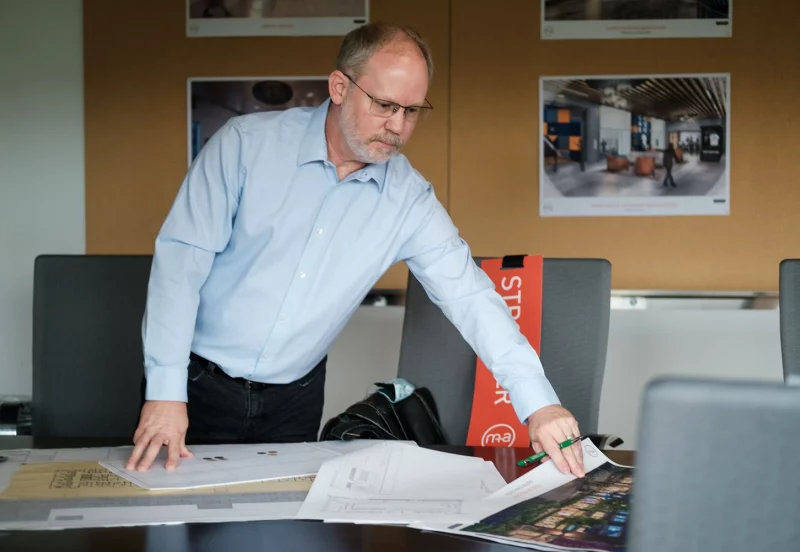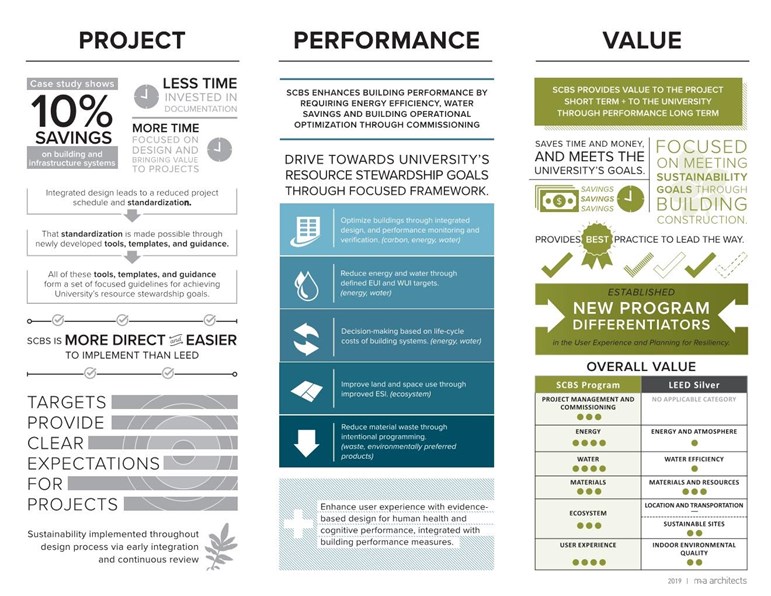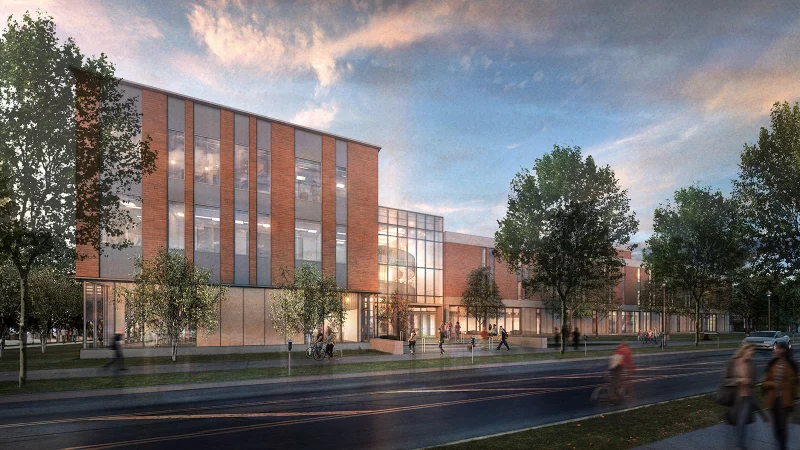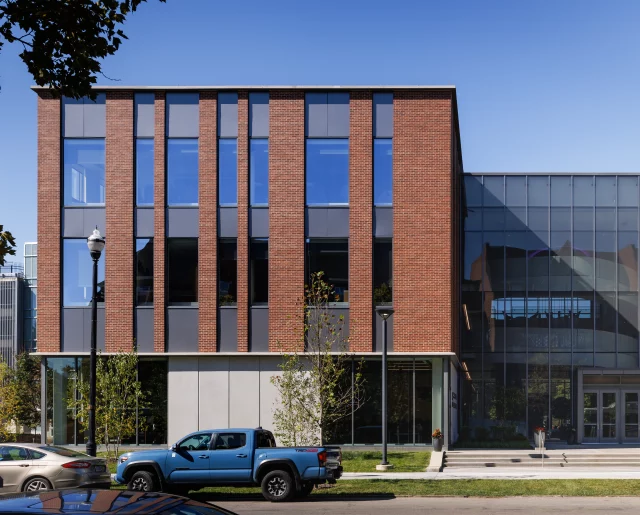Ohio State University – Champions Beyond the Field as They’re Among the First to Introduce Building Design Standards
The Ohio State University has always been recognized for innovation, demonstrating thought leadership in their approach to education and health and garnering respect in their internationally recognized research initiatives.
In 2019, the University asked themselves in what ways could their best be better, and began a journey to explore sustainability-driven building design standards for the university’s Time and Change projects.

As long-standing project design and delivery partners with the University, the team at MA Design was honored to be asked to serve as consultants for this initiative, using guidance from our in-house, nationally recognized, award-winning Sustainability Team, and my own expertise, as our Higher Education and Healthcare Team Lead, to determine the best possible solution today for the most sustainable world of tomorrow, in keeping with Ohio State’s Time and Change mission.
Our relationship in green building design and sustainability-driven practices at Ohio State really began in 2014, when we planned and designed the Mount Hall total building renovation as a LEED Silver project. In 2017 Ohio State’s commitment to energy efficiency ramped up, when they entered into a comprehensive energy management partnership, a 50-year concession between the university and Ohio State Energy Partners (ENGIE & Axium) to manage and optimize utilities on campus, including high voltage electric and natural gas consumption, with a goal to improve Ohio State’s energy efficiency 25% by 2027.
We were humbled when asked to join a task force to begin brainstorming a new standard for sustainable design for the Time and Change projects. The intent behind the task force was initially sparked by energy use and overall sustainability performance, to create a new standard that was unique to Ohio State based on best practices for the University, to improve on traditional industry standards like LEED certification.
ENGIE and the University pulled together the strongest taskforce of industry professionals possible – with MA Design and engineering firms MEP Associates (now Salas O’Brien) and PAE Consulting Engineers, acoustical and lighting specialists, energy and interior space consultants, along with representation from Facilities Operations and Design, Wexner Medical Center and the Sustainability Institute at OSU, to develop the SCBS (Sustainable Campus Building Standards). The task force pulled all of our strengths together to create the highest and best possible set of recommendations to align with the expectations for one of the country’s top-tier universities.

After the initial task force’s report was issued the University began a second round of development of the new Sustainable Design Standards, asking us to consult in partnership with the experts at HAWA Engineers. This time the team took the recommendations from the first round and compared them to the best things from LEED, WELL, Living Building Challenge, ASHRAE, IgCC and other sustainable standards to help the University implement their own, personalized, detailed process. Where the initial taskforce’s primary output was a self-supporting framework, the University also wanted to expand the reach of the sustainable campus building standards to be more holistically integrated with their Building Design Standards.
Ohio State had a unique opportunity – and obstacle – with the diversity, and complexity – of their campuses, coupled with their own energy infrastructures and resources. The Green Build and Energy Policy in place at the time for the University mandated LEED Silver for construction projects $4M and above was at once too inflexible to recognize the uniqueness of the facilities and infrastructure of the University, yet at the same time did not go far enough because of the sheer number of projects that fell below the threshold to require sustainable design and did not always advance Ohio State’s sustainability policies. However, it wasn’t a realistic option to disregard LEED, particularly with the University recognizing the importance, and prioritization, of sustainable design, prompting them to realize the need for their own set of standards to set the benchmark for what great, green, design looked like from that point forward.
The Sustainability Core Team then began getting to work, auditing and assessing the current approach, while determining the best-tailored plan for the University, to focus on advancing Ohio State’s established sustainability priorities and goals, not just on the main academic campus in Columbus, but on every campus, every building, every landscape – regardless of scope, type, or budget.
In October of 2020, the OSU Building Design Standards were amended with a new Division dedicated to the new Sustainability Standard, clearly listing sustainability requirements in this living document.

The standards extended beyond one set, and created customization per specific project, accomplished by developing a workflow matrix – addressing size and type of project – since different types of space have different needs. As an A/E using the new workflow, you figure out where your project fits, and apply sustainable design to those specific projects – rather than the one size fits all approach of hunting for points. This allows for the customization concept that can now be carried through on any project, in tailoring the best approach to each project’s individual needs.
Since October 2020, every construction project at the University must adhere to these sustainability principles and practices, a big change – and a welcome change.
In the end, the two project approaches had evaluated it all, above and beyond energy use – acoustics in classrooms and shared spaces, lighting quality both from the perspective of natural and artificial, air quality and the health of the occupants within the spaces all around campus, formulating and finalizing the set of standards we felt proud to encourage the University to publish.
The areas our plan addressed in the end, included:
Commissioning
Energy Efficiency
Water Use Efficiency
Ecosystem Services
Materials
User Experience
– Air Quality
– Thermal Comfort
– Acoustical Performance
– Daylighting + Lighting
– Connection to Nature
Life Cycle Cost Analysis
I am the most proud of the fact that, together with our amazing engineering teams and ENGIE, we were able to help The Ohio State University develop their sustainability standards in a way that’s going to have an impact on every project – instead of just the biggest projects. I believe how you do one thing is how you do everything, and their effort demonstrates their commitment to a better tomorrow, starting today.
I was so proud of our team, both at MA Design, with leaders in sustainable design like Johnna Keller leading with expertise and education to convince the project partners of the significance of these standards, and of the trusted colleagues we collaborated with that each brought critical knowledge and concepts to create the best possible outcome.
This is truly a legacy effort, one that will impact the lives and landscapes of our city, state, and The Ohio State University and the Wexner Medical Center campuses, far beyond my lifetime. The fact that the future of Ohio State will be healthier, not only in their design and physical footprint, but for the lives of those on campuses, from students to faculty and everyone in between, makes me believe in better, as the University inspires me to continue to challenge me to be my best.
It’s our responsibility as architects, designers, and individuals, to do everything we can today for the health and well-being of tomorrow, and these new design standards set the tone for just that.

